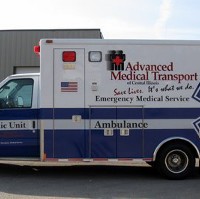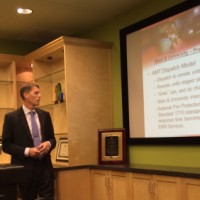Intersection changes have little effect on emergency response times
The movement of emergency vehicles through the intersection of Main and University streets in Peoria has not been impaired by the reconstruction that has otherwise slowed traffic, city and emergency officials said Wednesday.
Indeed, city leaders said, the intersection changes are bringing about the intended results ̶ to reduce the number of vehicles through the intersection, making it safer and increasing pedestrian traffic.
“We want the taxpayers to know the design of that intersection is working in the way it was designed,” said Second District City Councilman Chuck Grayeb. “We made this corridor as safe as we could possibly make it.”
That intersection was reconstructed earlier in the year chiefly to make it safer for pedestrians, most of them Bradley University students and personnel. By narrowing the number of lanes from five to three, widening sidewalks, putting on-street parking in place and installing new lights that will stop all vehicular traffic while pedestrian cross diagonally, that is being accomplished, said Grayeb.
It is not, however, impeding emergency vehicles, he said.
Said Mayor Jim Ardis, “We don’t need to be concerned that there is going to be a delayed response. Clearly, the data shows our citizens are not in danger because of one intersection.”
His remarks came during a news conference at Advanced Medical Transport after a City Council-ordered study of response times, sought by Grayeb and by At-Large Councilwoman Beth Jensen to ensure those times were not being adversely affected to the point of endangering people in need of emergency medical treatment.
Erik Bush, vice president of strategy and compliance at AMT, said roughly 1,400 calls that would take ambulances through the intersection were studied and it was found there was little change. With the key number being 30 second or less, he said the average time to get through the intersection is 21 seconds; however, it is 24 seconds since construction ended.
Bush said the response times are well within National Fire Protection Association standards. “We want to stress that really isn’t a change at all because many factors can impact the response time. In aggregate, we are seeing no change,” he said.
When the new intersection first opened many complained about the time it took to get through it, particularly at peak traffic times when it would take two or more signal cycles to make it through. That was basically the intention ̶ to get people to find alternative routes to reach Interstate 74 or other areas of the city, said City Engineer Scott Reeise.
“The goal was to make the area safer, more inviting to pedestrians. We wanted a 35 percent reduction in the traffic through that intersection and we are get very close to accomplishing that. We also wanted to see an increase in pedestrian users and we are seeing about a 60 percent increase to date, with about a quarter of those using the diagonal cross and all-way stop lights,” he said.
He added that businesses in the area are reporting increases in customers, largely because pedestrian traffic has grown.
Grayeb noted that the West Main Merchants Association, defunct for several years, is now “up and running. It is important that the commercial corridor is healthy, which helps keep the neighborhoods healthy.”
He and Jensen said they have heard positive feedback from residents of the neighborhoods surrounding that intersection and near the university.
“Safety was one of our priorities. We are hearing from residents they have a better sense of safety now,” Jensen said, referring not only to the Main and University intersection but other traffic-calming methods employed in surrounding neighborhoods.
Reiss said thorough studies will be done once the reconstruction of Sterling Avenue is completed. He said he believes more traffic will be diverted from Main and University once that happens.
Added Grayeb, “We’re not done. This is still a work in progress. We are waiting for the Sterling Avenue work to be done before we get complete metrics.”


